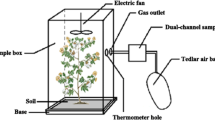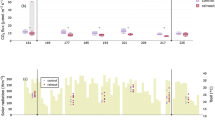Abstract
Young corn, pea and rapeseed plants were exposed to compressed synthetic air containing varying COS concentrations. The results suggest that COS exchange depends highly on the ambient COS mixing ratios. Ambient COS mixing ratios larger than 150 pptv resulted in a deposition of COS to all plant species studied. Significant (confidence level 95%) COS emission was only detected from rapeseed leaves at COS mixing ratios lower than 90 pptv. We computed COS compensation points around 90 (57–135) pptv and 144 (0–328) pptv COS for rapeseed and corn. For both plant species we found a close correlation between the photosynthetic CO2 assimilation and the COS uptake. In contrast to the gas exchange studies with corn and rapeseed, experiments with pea plants revealed neither a change in response to increased COS concentrations of between 350 and 900 pptv COS nor any correlation with photosynthesis. However, for all three plants studied we found indications that COS is taken up preferentially over CO2 under normal ambient conditions.
Similar content being viewed by others
References
Andreae MO & Jaeschke WA (1992) Exchange of sulphur between biosphere and atmosphere over temperature and tropical regions. In: Howarth RW, Stewart JWB & Ivanow MV (eds)Sulphur Cycling on the Continents (pp 27–61). Scope, John Wiley & Sons Ltd.
Ball JT (1987) Calculations related to gas exchange. In: Farquhar GD & Cowan IR (eds) Stomatal Function (pp 445–467). Stanford University Press, Stanford California
Berresheim H & Vulcan VD (1992) Vertical distribution of COS, CS2, DMS and other sulfur compounds in a loblolly pine forest. Atmos. Environ. 26A, 2031–2036
Bolin B (1983) C.N.P. and S Cycles: Major reservoirs and fluxes. The carbon cycle. In: Bolin B & Cook RB (eds) The Major Biogeochemical Cycles and Their Interactions (pp 41–45). SCOPE 21
Brown KA & Bell JNB (1986) Vegetation — The missing sink in the global cycle of COS. Atmos. Environ. 20, 537–540
Brown KA, Kluczewski SM & Bell JNB (1986) Metabolism of [35S]-carbonyl sulphide in perennial ryegrass (Lolium Perenne L.) and radish (Raphanus Sativus L.). Environmental and Experimental Botany 26, 355–364
Castro MS & Galloway JN (1991) A comparison of sulfur-free and ambient air enclosure techniques for measuring the exchange of reduced sulfur gases between soils and the atmosphere. Journal of Geophysical Research 96, 15,247–15,437
Chin M & Davis DD (1993) Global sources and sinks of OCS and CS2 and their distribution. Global Biogeochemical Cycles 7, 321–337
Crutzen PJ (1976) The possible importance of COS for the sulfate layer of the stratosphere. Geophys. Res. Lett. 3, 73–76
Cullis CF & Hirschler MM (1980) Atmospheric sulfur: Natural and man-made sources. Atmos. Environ. 14, 1263–1278
Degens ET (1989) Perspectives on Biogeochemistry. Springer Verlag, Berlin
De Kok LJ, Stahl K & Rennenberg H (1989) Fluxes of atmospheric hydrogen sulphide to plant shoots. New Phytol. 112, 533–542
De Kok LJ, Rennenberg H & Kuiper PJC (1991) The internal resistance in spinach leaves to atmospheric H2S deposition is determined by metabolic processes. Plant Physiol. Biochem. 29, 463–470
Fall R, Albritton DL, Fehsenfeld FC, Kuster WC & Goldan PD (1988) Laboratory studies of some environmental variables controlling sulfur emissions from plants. J. Atmos. Chem. 6, 341–362
Goldan PD, Kuster WC, Albritton DL & Fehsenfeld FC (1987) The measurement of natural sulfur emissions from soils and vegetation: Three sites in the eastern United States revisited. J. Atmos. Chem. 5, 439–467
Goldan PD, Fall R, Kuster WC & Fehsenfeld FC (1988) The uptake of COS by growing vegetation. A major tropospheric sink. J. Geophys. Res 93, 14,186–14,192
Guenther A, Lamb B & Westberg H (1989) US national biogenic sulfur emissions inventory. In: Saltzman ES & Cooper WJ (eds) Biogenic Sulfur in the Environment (pp 15–30). American Chemical Society, Washington DC
Hoagland DR & Arnon DJ (1950) The water-culture method of growing plants without soil. Univ. California, Berkeley Coll. Agr. Circ. 347
Hofmann DJ (1990) Increase in the stratospheric background sulfuric acid aerosol mass in the past 10 years. Science 248, 996–1000
Hofmann U, Hofmann R & Kesselmeier J (1992a) Field measurements of reduced sulfur compounds over wheat during a growing season. In: Schwartz SE & Slinn WGN (eds) Precipitation Scavenging and Atmosphere-Surface Exchange. Volume 2 — The Semonin Volume: Atmosphere-Surface Exchange Processes (pp 967–977). Hemisphere, Washington DC
Hofmann U, Hofmann R & Kesselmeier J (1992b) Cryogenic trapping of reduced sulfur compounds under the influence of a NAFION Dryer and cotton wadding as an oxidant scavenger. Atmospheric Environment 26, 2445–2449
Kesselmeier J (1991) Emission of sulfur compounds from vegetation and global-scale extrapolation. In: Sharkey ThD, Holland EA & Mooney HA (eds) Trace Gas Emissions from Plants (pp 261–265). Academic Press, San Diego, USA
Kesselmeier J (1992) Plant physiology and the exchange of trace gases between vegetation and the atmosphere. In: Schwartz SE & Slinn WGN (eds) Precipitation Scavenging and Atmosphere-Surface Exchange. Volume 2 — The Semonin Volume: Atmosphere-Surface Exchange Processes (pp 949–966). Hemisphere, Washington DC
Kesselmeier J, Meixner FX, Hofmann U, Ajavon A, Leimbach St & Andreae MO (1992) Distribution of ozone over a tropical rain forest and exchange of reduced sulfur compounds between tropical trees species and the atmosphere: Investigations from the atmospheric boundary layer, at ground level and from the top of the canopy. In: Hallé F & Pascal O (eds) Biologie d'une Canopée de Forêt Équatoriale — II. Rapport de mission: Radeau des Cimes Octobre/Novembre 1991 (pp 247–263). Reserve de Campo, Cameroun ISNB-No 2-950 6703-1-8
Kesselmeier J, Meixner FX, Hofmann U, Ajavon A, Leimbach St & Andreae MO (1993) Reduced sulfur compound exchange between tropical tree species and the atmosphere: Measurements in the atmospheric boundary layer, at ground level (forest clearing) and at the canopy top. Biogeochemistry 23: 23–45
Kluczewski SM, Brown KA & Bell JNB (1985) Deposition of [35S]-carbonyl sulphide to vegetable crops. Radiat. Protect. Dosim. 11, 173–177
Lamb B, Westberg H, Allwine G, Bamesberger L & Guenther A (1987) Measurement of biogenic sulfur emissions from soils and vegetation: application of dynamic enclosure methods with Natusch filter and GC/FPD analysis. J. Atmos. Chem. 5, 469–491
Mihalopoulos N, Bonsang B, Nguyen BC, Kanakidou M & Belviso S (1989) Field observations of carbonyl sulfide deficit near the ground: Possible implication of vegetation. Atmospheric Environment 23, 2159–2166
Miller AG, Espie GS & Canvin DT (1989) Use of carbon oxysulphide, a structural analog of CO2, to study active CO2 transport in the cyanobacterium Synechococcus UTEX 625. Plant Physiol. 90, 1221–1231
Protoschill-Krebs G (1991) Untersuchungen zur Aufnahme und zum Metabolismus von Carbonylsulfid in Pflanzen. Ph.D. Thesis, Johannes-Gutenberg-University of Mainz, FRG
Protoschill-Krebs G & Kesselmeier J (1992) Enzymatic pathways for the metabolization of carbonyl sulphide (COS) by higher plants. Botanica Acta 105, 206–212
Rennenberg H, Huber B, Schröder P, Stahl K, Haunold W, Georgii H-W, Slovik S & Pfanz H (1990) Emission of volatile sulfur compounds from spruce trees. Plant Physiol. 92, 968–971
Solomon AM, Trabalka JR, Reichle DE & Voorhees LD (1985) The global cycle of carbon. In: Trabalka JR (eds) Atmospheric Carbon Dioxide and the Global Carbon Cycle (DOE/ER-0239) (pp 3–13). Oakridge National Laboratory, Oak Ridge, Tennessee
Spedding DJ, Ziegler I, Hampp R & Ziegler H (1980a) Effect of pH on the uptake of 35S-sulfur from sulfate, sulfite, and sulfide by Chlorella vulgaris. Z. Pflanzenphysiol. 97, 205–214
Spedding DJ, Ziegler I, Hampp R & Ziegler H (1980b) Effect of pH on the uptake of 35S-sulfur from sulfate, sulfite, and sulfide by isolated spinach chloroplasts. Z. Pflanzenphysiol. 96, 351–364
Taylor GE, McLaughlin SB, Shriner DS & Selvidge WJ (1983). The flux of sulfur-containing gases to vegetation. Atmos. Envir. 17, 789–796
Turco RP, Whitten RC, Toon OB, Pollack JB & Hamill P (1980) OCS, stratospheric aerosols and climate. Nature 283, 283–286
Warneck P (1988) Chemistry of the Natural Atmosphere. Dmowska R & Holton JR (eds) International Geophysics Series Vol. 41. Academic Press, San Diego, USA
Author information
Authors and Affiliations
Rights and permissions
About this article
Cite this article
Kesselmeier, J., Merk, L. Exchange of carbonyl sulfide (COS) between agricultural plants and the atmosphere: Studies on the deposition of COS to peas, corn and rapeseed. Biogeochemistry 23, 47–59 (1993). https://doi.org/10.1007/BF00002922
Received:
Accepted:
Issue Date:
DOI: https://doi.org/10.1007/BF00002922




